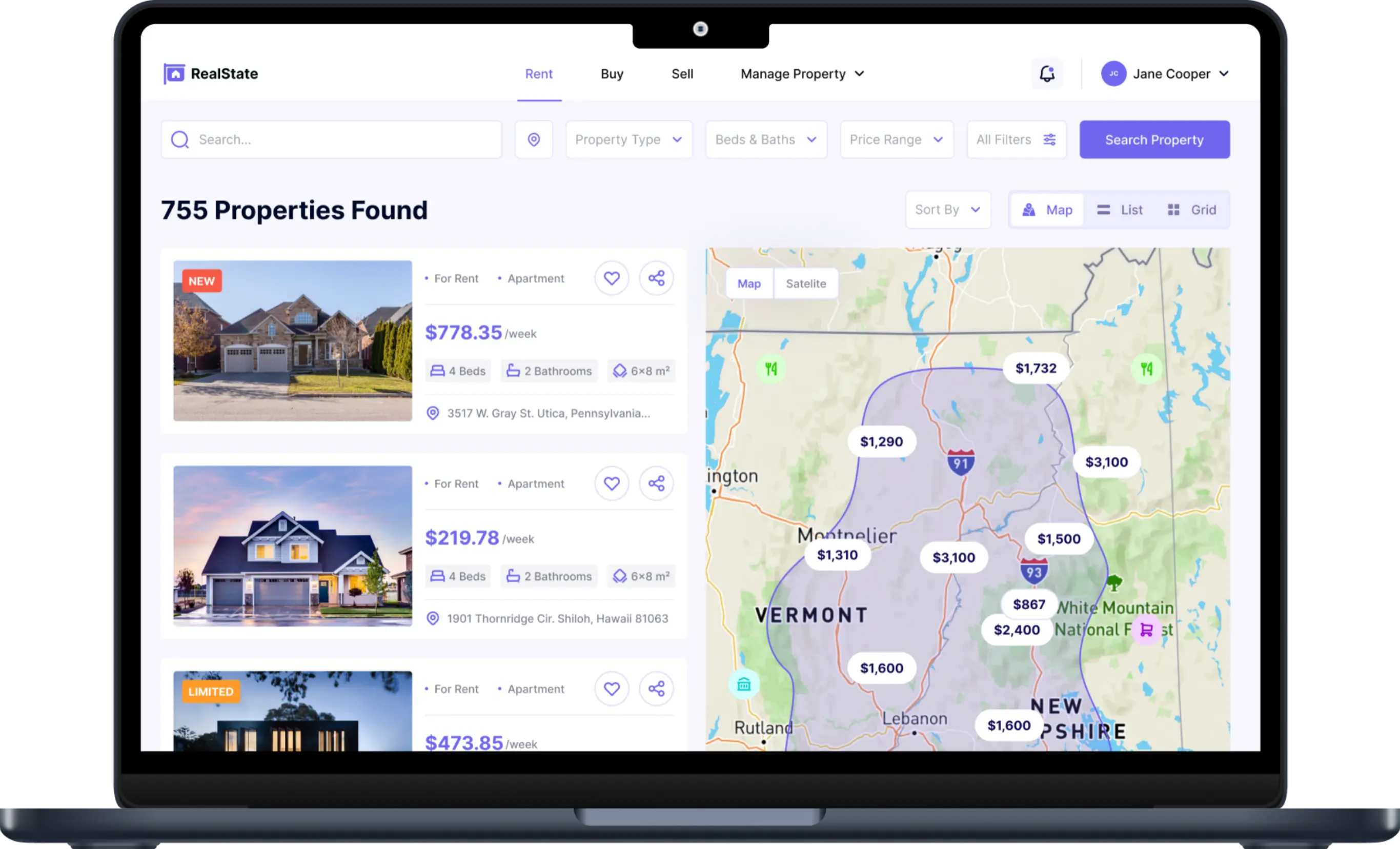Engineering Quality Solutions
We built an authentic yet engaging real estate web portal that helped our client enhance their property visibility quickly. Selling and renting out properties became easier for our client after we developed a full-fledged website portal for their real-estate company.
INDUSTRY
REAL ESTATE
YEAR
2023
LOCATION
UAE

One of our property owner clients' major needs was to enhance their properties' visibility for both selling and renting purposes.
Data integration from various sources, including real estate agents, brokers, and property owners, was a tedious task and challenge we were ready to face while developing the portal.
We wanted to design an upgraded UI that can be a win-win for property owners and seekers.
All the property owners shared highly confidential details with us; hence, data safety and protection was one of our biggest challenges.
There are numerous online portals in the real estate industry, so we were trying to be better and smarter by giving cutting-edge competition to them.
We came up with one of the most modern solutions for our real-estate client integrated with Augmented Reality to deliver a flawless property buying experience. From developing an excellent frontend to a robust backend, our real estate project is a HIT!


















Below are some of the most important features that helped our real-estate portal become more engaging and interesting.




Design is the core of any mobile application. Our web development team spent a good time researching and implementing a robust real-estate platform design. Also, we conducted usability testing to ensure smooth functioning and navigation of the website. We finally developed an exciting web design format that proves highly affirmative and engaging for property sellers and buyers.
Post-design, our full-stack development team was busy developing the robust web backend by streamlining the different properties into specific locations and price tags. We wanted to deliver clean, efficient, and scalable code that can be easily edited in the future for improvements and upgrades. Finally, we developed a worthwhile product for the online real estate market.
We at SolGuruz follow a detailed website development process to deliver excellence. Let’s dive deep into the process.
Here, we understand the client’s initial and long-term job requirements to give a valid yet reliable quotation mentioning cost and timeline.
Our development team starts settling for the application's core by defining a user-perspective UX/UI interface to attract maximum engagement.
We follow the agile development process for building a thoughtful and reliable app, followed by rigorous app testing practices to launch a fully functional website.
We optimize the software with 100% configuration to launch it in the LIVE market by setting up servers, data management, and other infrastructure components.
Here is a quick understanding of the buyer's and seller's user flow design. It includes the user journey from registration to accepting the offers.

We do required research based on available comparative market apps.

There are various aspects of security taken care of. They include Network security, Data security, Cloud Security, Application Security, and Endpoint security.
Encrypted the data both in transit and at rest by using methods like full disk encryption and Encrypted web connection(HTTP protocol with SSL certificate.
oAUTH2.0 helps prevent maliious attacks orchestrated by unauthorized users and makes sure that system is accessed by only authorized and authenticated users.
Configured Firewalls on AWS instances and databases to allow limited access.
Implemented Source code obfuscation practices to make the source-code in unreadable format, and so it would be difficult to temper or reverse engineer the released app’s executable file.
Configured cloud instances to take backup at regular intervals and so a particular version can be rolled back when required automatically.
Finally, we built a successful real estate web portal solution that helps our real-estate clients sell and rent their properties 5X faster than any other portals.
The product developed by SolGuruz is very appreciated by end customers, and the client is very pleased with their work overall. The team is very communicative and knowledgeable, and they deliver on time and within budget. Additionally, they’re very flexible to constantly changing requirements.

Aditi Fozdar
COO, Jalso

FlexiPe - Buy Now Pay Later (BNPL) App Solution
Get insights from FlexiPe App’s Case Study relates to the Buy Now Pay Later model, offering a comprehensive analysis of the BNPL App.

Leafbis - Cannabis Delivery App Development
We have designed and developed a Cannabis and Marijuana delivery application that facilitates users to order prescribed weeds and cannabis online.
Don’t Just Dream Big - Let’s Make It Happen!
For over a decade, I’ve been at the forefront of turning bold, ambitious ideas into groundbreaking solutions. As the CEO of SolGuruz, I’ve had the privilege of helping startups and businesses not only tackle their biggest challenges but scale to new heights with products that don’t just compete - they dominate.
Every meeting with me isn’t just a conversation; it’s a launchpad for revolutionary ideas that can catapult into great products/services. Leaders who’ve taken the step to connect with me have walked away with actionable strategies that made their products unforgettable.
👉 Book a free strategy call with me now and experience the difference. This isn’t just advice - it’s the spark you need to ignite your next big breakthrough.
In a world full of ordinary, let’s create the AI-extraordinary.
Your moment is now - don’t let it pass by.
Paresh Mayani
CEO, SolGuruz
paresh@solguruz.us